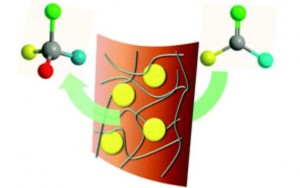 Membranes are versatile supports for the immobilisation of catalysts; they allow the use of different manufacturing materials and their properties such as pore size, morphology, flexibility, chemical and thermal stability can be finely tuned. These polymeric membranes have successfully been used to support chiral complexes of ruthenium-Binap and manganese-Salen in enantioselective epoxidation and hydrogenation reactions. Although versatile and ideal for industrial scale applications, their major drawback proved to be metal leeching, which reduced their efficiency and contaminated the products.
Membranes are versatile supports for the immobilisation of catalysts; they allow the use of different manufacturing materials and their properties such as pore size, morphology, flexibility, chemical and thermal stability can be finely tuned. These polymeric membranes have successfully been used to support chiral complexes of ruthenium-Binap and manganese-Salen in enantioselective epoxidation and hydrogenation reactions. Although versatile and ideal for industrial scale applications, their major drawback proved to be metal leeching, which reduced their efficiency and contaminated the products.
Research groups lead by Barbaro recently developed a series of organic/inorganic polymeric membranes incorporating rhodium complexes of chiral diphosphino ligands that proved nearly immune to metal leeching and provided clean, enantioselective hydrogenation of methyl-2-acetoamidoacrylate with enantiomeric excesses comparable with their homogeneous analogues. The novelty of the approach resided in the incorporation of the metal occurring on the preformed membrane, thus avoiding derivatisation steps and chemical modifications.
The reaction times proved to be considerably longer than the homogeneous catalyst with yields exceeding 90 % only after 17 hours, but enantioselectivities of up to 98 % could be achieved without any loss of activity after five cycles using methanol as the solvent. A screening of several other substrates and solvents proved the versatility of the system. Remarkably, the most performing membranes presented a metal leeching of less than 1 ppm even after 25 hours of use in methanol, outperforming existing catalytic membranes. The stability of the membrane-complex adduct is thought to reside in the interaction between the metal and tungsten oxide (WO3) or sulphite anions in the membrane structure.
Find more about the article here.
Enantioselective hydrogenation of prochiral substrates in catalytic membrane reactors
Pierluigi Barbaro, Claudio Bianchini, Francesca Liguori, Claudio Pirovano and Haruo Sawa
Catal. Sci. Technol., 2011, Advance Article
DOI: 10.1039/C0CY00030B, Communication










